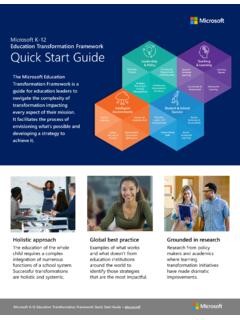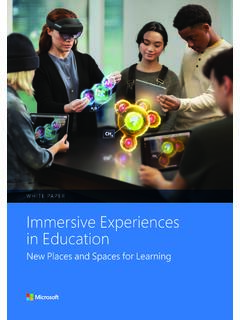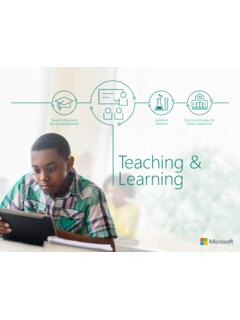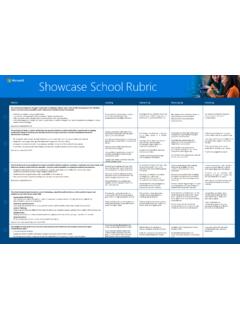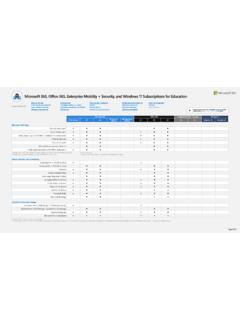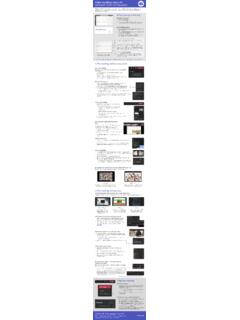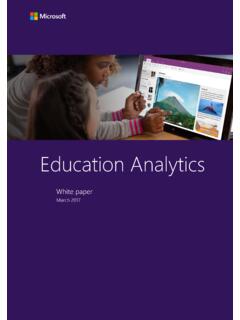Transcription of The Future of Learning
1 Remote to Hybrid Learning A P O S I T I O N P A P E R O N A P A R A D I G M S H I F T F O R E D U C A T I O N Education Reimagined: The Future of Learning The fallout from COVID-19, continuing advances in digital technology, and intensifying pent-up demand for student centered Learning have combined to present an unprecedented opportunity to transform education across whole systems. We have been impressed by the tireless action to address the emergency needs of students and families. We are deeply encouraged by the growing desire to seize the opportunity to focus on the deep purpose of education through the twin pillars of well-being and Learning . Learning for all will spark a new interest and commitment to equity, where diverse students will be drawn to Global Competencies (such as our 6Cs), Learning more about their worlds as they commit to building a better Future for themselves and humanity.
2 This powerful shift to a learner-centered system will be amplified by technology and driven by education that is steeped in purpose and meaning. We are excited to join Microsoft to help accelerate this development. Michael Fullan and Joanne Quinn Global Directors, New Pedagogies for Deep Learning Over the last few months, system leaders, educators, students, and families across the globe have demonstrated incredible energy, commitment, and flexibility as they quickly responded to the need to move to remote Learning . During this shift, technology has played a critical role in enabling students to stay connected, engaged, and motivated. Teachers around the world are continuing the Learning journey for their classes by integrating video, game-based Learning , and powerful collaboration tools into their virtual lessons, and students are experiencing a new type of Learning , which will have an important, lasting impact.
3 Institutional leaders have told us that going online was about more than remote instruction it was about implementing solutions that would keep departments running smoothly and evolve with the changing needs of students and staff. Even with all the incredible fast work, administrators and leaders acknowledge they are navigating unchartered territory, and there is more to be done to ensure all students can participate. As we look to the next school year and beyond, system leaders, educators, faculty, students, and families will apply what they ve learned throughout the process, and work together to plan and shape the Future of education. This paper, created in collaboration with global visionaries from New Pedagogies for Deep Learning , explores the now, the near, and the next in the changing landscape of education. We hope you will find this contribution to the existing conversation about the shift from traditional to remote to new hybrid Learning approaches valuable in your return-to-school planning, and beyond.
4 Barbara Holzapfel General Manager, Microsoft Education Authors: Michael Fullan, Joanne Quinn, Max Drummy, Mag Gardner Access a digital copy of this paper here. Education Reimagined | The Future of Learning 3 Education Reimagined: The Future of Learning The pandemic has disturbed all sectors of society and revealed its fault lines especially in our education systems. The reaction to the crisis has generated some impressive responses on the part of individuals and small groups as educators have stepped up to serve their communities. In some cases, public and private partnerships have filled the gaps. Some systems have been able to rapidly deliver remote Learning experiences, but most have struggled with meeting the needs of all. Equity, access and capacity left wanting. Prior to the pandemic, many education systems were stalled, the pandemic exposed the case that fundamental changes are needed.
5 Through this disruption, there has been a recognition that schools play a vital role beyond Learning . Their custodial and community roles are central to a healthy society. As we grapple with the issues of reopening schools in this uncertain time, we must seize the opportunity to reflect on what has been learned, and what matters most. The challenges highlighted during the disruption should not come as a surprise. Over the last decade, student engagement has Almost one in every five students does not reach a basic minimum level of skills to function in today s society (OECD) Moreover, many school systems have not maintained pace with technological advances; schools have not provided widespread access to digital tools. When the pandemic hit, 1 in 5 students did not have access to the internet or a device to support them in This disruption revealed systems that already struggled to support all learners.
6 To put it plainly: it s time to situate education as an instrument of individual and societal good. How will we choose to respond? Will we patch together a reaction, or use this opportunity to transform the system itself? The question becomes, what will be more appealing - reverting to the status quo or using the opportunity to help students become knowledgeable and skilled change makers through deeper Learning ? We argue that the solutions lie before us. We have the opportunity to creatively manage the immediate issues while building a bridge to a reimagined education system. We outline this strategy in three Phases. Phase 1 Disruption identifies initial responses and the lessons learned during the first months of the pandemic. Phase 2 Transition outlines how to navigate planning for reopening, when the pandemic is still creating uncertainty. Phase 3 Reimagining lays out a vision for an educational approach that enables all students to thrive and prepares them with skills to navigate ambiguity and change.
7 This phase draws from the best of traditional approaches, innovative practices, and insights from remote Learning to shape new, flexible, agile hybrid deep Learning models. Phase 1 Disruption Shifting to Remote Learning Phase 2 Transition to Reopening Schools Phase 3 Reimagining Learning Navigate the Zones of Disruption: Unsettled - Learning - Growth Manage the structures, processes and decisions needed to reopen schools. Create an agile, innovative and Future focused hybrid deep Learning system. Education Reimagined | The Future of Learning 4 In each of these three phases, we emphasize how new approaches would enable well-being, equity and quality (deep) Learning to flourish. In order to realize such improvement, it is imperative to embrace an innovative mindset. We will need to be open to rethinking and creating a powerful new Future that meets everyone s needs.
8 Phase 1 Disruption: Shifting to Remote Learning Navigating the Disruption Not everyone or every system had the same experience in facing this abrupt change. Some systems had stronger collaboration and technology infrastructure which assisted them in a more rapid response while others were struggling to find the right pathway. When we examined the ways that systems responded to this global emergency, we identified three zones that both individuals and systems experienced as they navigated the Disruption Phase. We named these: The Unsettled Zone, The Learning Zone and The Growth Zone. The zones are not finite, or discrete and may not be sequential. The Learning Zone provides insights about how to move forward during disruption. The Growth Zone involves ideas about how to approach the Transition phase of reopening schools. These phases describe the focus and responses to the crisis as it initially evolves.
9 As circumstances change, individuals, schools and systems may move back and forth through the zones as they build expertise and the situation changes. The power of the zones metaphor is to provide a lens for individuals and systems to recognize where they are functioning and then take action. Our success was driven by our people being ready to be adaptive, innovative in the context that we're This Covid 19 moment's an unfortunate situation, but the good news is our educators and staff had built their capacity and continued to be adaptable. Phil Neufeld, Fresno Unified School District, California Education Reimagined | The Future of Learning 5 Figure 1. Navigating the Disruption3 The Unsettled Zone In the Unsettled zone, the shock and immensity of the change may be overwhelming. Emotions run high and responses focus on solving the immediate structural and procedural issues.
10 A rapid response is essential in providing meals, getting devices delivered and building connectivity in underserved areas. In terms of pedagogy, Learning on-line in the unsettled zone looks more like traditional teacher centered, content-driven practice. Figure 2. Global monitoring of school closures caused by COVID-19 At the pandemic s peak billion students were out of This move was abrupt and unprecedented, leaving policy makers and practitioners scrambling to provide a safe and expedient way to provide Learning at home. Remote Learning became the quick fix. The lack of access and connectivity meant that students would be denied schooling for weeks of shut down. Copyright 2020 by Education in Motion (NPDL). All rights reserved. Education Reimagined | The Future of Learning 6 For example, according to PISA, slightly more than two-thirds of 15-year-old students in OECD countries were enrolled in schools where digital devices had sufficient computing capacity.
